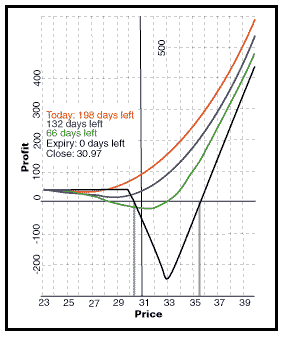Q&A
Explore Your Options
| Got a question about options? Tom Gentile is the chief options strategist at Optionetics (www.optionetics.com), an education and publishing firm dedicated to teaching investors how to minimize their risk while maximizing profits using options. To submit a question, post it on the STOCKS & COMMODITIES website Message-Boards. Answers will be posted there, and selected questions will appear in future issues of S&C. | 
Tom Gentile of Optionetics |
RATIO BACKSPREAD
Could you please explain what a ratio backspread is? -David BJ
A ratio backspread is a delta-neutral strategy that is directional in nature, and allows the trader to enter the position with a zero debit or credit (margin is required). The trade is designed to profit from a large move in the underlying but lose little or nothing should the underlying move in the opposite of the intended direction. Generally, the trade is set up when the implied volatility of the underlying options is low, and more options are purchased than sold. The idea is that the options you sell should pay for all of the long options. The most common ratios are one option sold for every two bought, or two sold for three bought (known as 1x2 and 2x3 ratios, respectively). Of course, you can have any ratio you want, but the math becomes complex, and your ability to generate a sufficient profit to justify the ratio becomes questionable with higher ratios.
The risk curve shown in Figure 1 shows a 1x2 ratio backspread on the QQQs, created by shorting the 30 strike calls and buying the 33. The colored lines represent various time intervals during the course of the trade, beginning with today (red line) to expiration (black line).

Figure 1: risk curve. This is the risk curve for a sample 1x2 ratio backspread.
As you can see, there is not much risk in the trade until it is close to expiration. This is why we refer to these types of trades at Optionetics as "vacation trades." You can set 'em and forget 'em for a while if the large move you expect doesn't take place right away.
Margin is required on this type of trade, since you do have at least one short option that is closer to the money than the long. The margin is determined by the distance between the strikes, minus the credit or plus the debit incurred.
ATM LEAPS
If I buy an at-the-money-- (ATM) 15 strike call LEAP-- and sell a short-term ATM 15 strike call, what happens on expiration if I get assigned? Would there be an upfront margin requirement on this option play?-D. Diebold
Since this position is your plain-vanilla calendar spread in which both strikes are the same, there is no additional margin required to sell the short-term call. If you are assigned at expiration because the stock finishes in-the-money-- (ITM), say at $16, then you will be short the stock at 15 and lose $1 on that position. However, you are still long the LEAP 15 call, and can exercise the right to buy back the short at $15. Exercising may not be the best method, however, since your LEAP was partly "paid down" by the money you took in for the short position. It may therefore have enough time value left to offset the $1 loss on the short stock.
A combination of being short the stock and long a call is known as a synthetic put and can make money to the degree the stock trends down, minus the net debit of the LEAP. Alternatively, since you are now short the stock, you have a chance to earn more premium by buying back the stock and selling another short-term option against the LEAP. Provided the stock continues to trade within a close range of the strike prices, you can repeat this a few times until you eventually own the LEAP outright. This will give you a risk-free trade at that point. If you don't have enough money in your trading account to cover the margin requirements on the short assignment, then you will be forced either to deposit funds immediately or to liquidate the LEAP, thereby losing your time value and creating a total loss equal to the original debit of the trade.
COVERED CALLS
Under what circumstances would a stock be called if you have covered calls on a NASDAQ stock?
Regardless of the exchange it's on, when the stock trades higher than the strike sold at expiration, it will be called away from you. If it's within 25 cents of the strike, it could go either way, since the transaction costs may be greater than it is worth to the other side to call the stock away.
Options that are closer to expiration generally stand the greatest risk of assignment. If you've sold a covered call with a near-term option (say it expires within 30 days), generally you will be assigned, or have your stock called away, before those traders who have longer-term short calls (say more than 30 days).
--Optionetics Platinum
--See Editorial Resource Index
-- See Traders' Glossary for definition
Return to September 2003 Contents
Originally published in the September 2003 issue of Technical
Analysis of STOCKS & COMMODITIES magazine.
All rights reserved. © Copyright 2003, Technical Analysis, Inc.